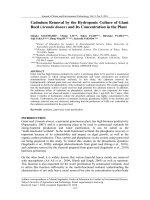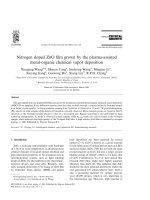- Trang chủ >>
- Khoa Học Tự Nhiên >>
- Vật lý
Amorphous silica nanowires grown by the vapor–solid mechanism
Bạn đang xem bản rút gọn của tài liệu. Xem và tải ngay bản đầy đủ của tài liệu tại đây (346.99 KB, 6 trang )
Amorphous silica nanowires grown by the
vapor–solid mechanism
Ki-Hong Lee
a,
*
, Seung-Woo Lee
a
, Richard R. Vanfleet
b
, Wolfgang Sigmund
a
a
Materials Science and Engineering Department, University of Florida, 255 Rhines Hall, Gainesville, FL 32611, USA
b
Advanced Materials Processing and Analysis Center, University of Central Florida, Orlando, FL 32816, USA
Received 22 May 2003; in final form 3 June 2003
Published online: 9 July 2003
Abstract
Silica nanowires were synthesized by using silica nanoparticles as a growth catalyst using a gas composed of CH
4
and H
2
at 1050 °C. Silica nanoparticles provide silicon and oxygen atoms for the formation of the nanowires, as well
acting as a growth site. The nanowires nucleated on graphitic carbon layers formed around the seed particles, indicating
that the nanowires grow by the vapor–solid mechanism. Photoluminescence spectra of the nanowires normally showed
strong blue emission peaked at 3.1 and 2.8 eV under 3.8 eV laser excitation. Post-hydrogen annealing resulted in the
appearance of longer wavelength photoluminescence band.
Ó 2003 Elsevier B.V. All rights reserved.
1. Introduction
One-dimensional quantum nanowires are
promising materials for nanoelectronic devices due
to their small dimensions and unique physical
characteristics. Various kinds of one-dimensional
structures, such as carbon nanotubes [1,2] semi-
conductor nanowires [3,4] and oxides [5], have
been studied for applications in nanoelectronic
devices. Wide band gap semiconductor light-
emitting nanowires are useful for visible display
devices and optoelectronics [6]. Amorphous semi-
conducting materials, such as Si–C–H, can be
synthesized with various compositions, to manip-
ulate the optical properties in an extremely wide
range [7]. Amorphous silica is widely used in sili-
con based integrated devices and can also be
produced as nanowires. Yu et al. [8] showed that
amorphous silica nanowires (SiONWs) emit blue
light and might hence be applied in integrated
optical devices. The vapor–liquid–solid (VLS)
process is a fundamental mechanism for the
growth of SiONWs similar to other kinds of one-
dimensional nanomaterials [9–11].
In this study, a new approach to nucleate and
grow SiONWs is presented. Silica nanowires
(SiONWs) with small diameter (15–40 nm) were
produced using silica nanoparticles as a nucleation
catalyst at 1050 °C in a highly reducing atmo-
sphere. The amorphous silica nanowires are
Chemical Physics Letters 376 (2003) 498–503
www.elsevier.com/locate/cplett
*
Corresponding author. Fax: +1-352-846-3355.
E-mail address: khonglee@ufl.edu (K H. Lee).
0009-2614/03/$ - see front matter Ó 2003 Elsevier B.V. All rights reserved.
doi:10.1016/S0009-2614(03)01019-4
nucleated from graphitic carbon layers, which are
formed around the seed silica nanoparticles. This
fact implicates that the silica nanowires grow by
vapor–solid (VS) mechanism, not by vapor–
liquid–solid (VLS) mechanism. The SiONWs show
strong blue emission, and a longer process time
and hydrogen annealing after synthesis of the
nanowires results in the emission of longer wave-
length spectrum.
2. Experimental section
N-type silicon h100i wafers (3 X-cm, 1 Â 1 cm)
were used as substrates for the growth of SiONWs.
After thermally oxidizing the Si substrates; iron
films of 30 nm were deposited on the oxide layer by
sputtering. A droplet of aqueous 20 nm silica
nanoparticles (0.1 wt%, 0.2 ml) solution was
placed on a Fe/SiO
2
/Si substrate. Poor wetting of
the aqueous silica solution on the substrate caused
non-uniform coverage of silica nanoparticle layers.
The substrates were heated up to 100 °C on a hot
plate in order to expedite the drying process. After
annealing in H
2
(200 sccm) for 10 min at 1050 °C,
SiONWs were synthesized in a quartz tube furnace
with a tube diameter of 1.5 in. in a gas mixture
consisting of CH
4
(10 sccm) and H
2
(200 sccm). A
constant flow of Ar (1000 sccm) through the
quartz tube was performed to purge the quartz
tube during heating and cooling.
A field emission scanning electron microscope
(FESEM, JEOL 6335F) was used to investigate
the growth characteristics of SiONWs on the
substrates. A transmission electron microscope
(TEM, JEM 4010), equipped with energy disper-
sive X-ray spectroscope (EDX), was used for
structure and composition analysis. Electron en-
ergy loss spectroscopy (EELS, Tecnai F30) was
carried out for further characterization of the
nanowires. Photoluminescence (PL) was measured
at room temperature using a He–Cd laser with 325
nm excitation wavelength in the spectral range of
350–700 nm.
3. Results and discussion
Due to poor wetting of aqueous silica solution
on the substrate, the coverage of silica nanoparti-
cles was non-uniform as described in Section 2.
Low magnification FESEM studies (Fig. 1a)
Fig. 1. (a) A low magnification FESEM photograph showing two distinctly different regions on the substrate after synthesis. (b)
Nanowires grown in the region covered by silica nanoparticles. (c) Surface morphology in the region not covered by silica nanoparticles
(no nanowire is observed).
K H. Lee et al. / Chemical Physics Letters 376 (2003) 498–503 499
revealed two distinct regions on the substrate sur-
face after synthesis. SiONWs grew up to tens of lm
in length on the silica nanoparticles. Graphite, iron
carbide, and few carbon nanotubes were found in
the regions where no silica particle existed. High
magnification FESEM photographs of these two
regions show the difference (Figs. 1b and c).
Formation of the amorphous SiONW phase
could be identified by high resolution transmission
electron microscopy (HRTEM), electron disper-
sive spectroscopy (EDS), electron energy loss
spectroscopy (EELS) as well as selected area dif-
fraction (SAD) pattern analysis. A low magnifi-
cation TEM photograph, as shown in Fig. 2a,
shows the nanowires grown from the seed parti-
cles. The diameter of the nanowires ranges be-
tween 15 and 35 nm. Process time did not affect the
length and the diameter of the nanowires signifi-
cantly. An EELS spectrum, as shown in Fig. 2b,
reveals that the nanowires have amorphous silicon
oxide phase by comparing to the standard EELS
spectrum for amorphous silica. Figs. 2c and d
show HRTEM photographs and SAD patterns of
a nanowire and a seed particle, respectively. The
SAD pattern and HRTEM photographs from the
seed regions indicate that crystalline graphitic
layers formed around the seed particles. EDS
spectra, as shown in Fig. 3, reveals different com-
positions according to positions in a nanowire. In
addition to silicon and oxygen, high concentration
of iron and carbon was detected from seed particle
regions and carbon from regions near the seed
particles. Carbon which was detected from the
nanowires, as shown in Fig. 3c, is negligible and
seems to arise from the surface contamination due
to focused electron beam. Calculated compositions
of the nanowire from the EDS reveal the forma-
tion of oxygen deficient silica phase (SiO
2Àx
).
Silica nanoparticles act as nucleation sites, as
well as they provide oxygen and silicon for the
SiONW growth. Catalytic decomposition of CH
4
occurs on the iron film surface. Fig. 4a shows a
Fig. 2. (a) A low magnification TEM photograph of the amorphous nanowires. (b) EELS spectrum from the amorphous nanowire.
The profile resembles that of the standard EELS spectrum of amorphous silica. (c) A HRTEM photograph and a SAD pattern
showing the amorphous characteristic of the nanowires. (d) A HRTEM and a SAD pattern from the seed part showing graphitic
carbon layers surrounding the seed particles.
500 K H. Lee et al. / Chemical Physics Letters 376 (2003) 498–503
schematic diagram of growth mechanism of
SiONWs on the agglomerated silica nanoparticles.
The Fe films act as a catalyst decomposing CH
4
gas into carbon and hydrogen atoms. The carbon
atoms decompose the silica nanoparticles; and SiO
and carbon monoxide (CO) vapor are formed. The
CO gas could be reduced to carbon and oxygen
atoms by the catalytic activity of the Fe films. The
oxygen and the SiO vapor diffuse up to top regions
of the silica particle layers to form the nanowires.
In an initial stage of the nanowire growth, iron
vapor forms a Fe–Si–O phase, as shown in Fig. 3b,
with silica at the surface of the silica nanoparti-
cles; and the carbon atoms form graphitic layers
around the nanoparticles, as shown in Fig. 2d. The
existence of the graphite phase surrounding
the seed particles is a reasonable indication that
the nanowires grew by VS mechanism. Carbon
vapor rich environment in the initial stage forms
an amorphous diamond like carbon (DLC) phase
in the nanowire near the seed particles, as shown in
Fig. 3c. Following the initial stage, carbothermal
decomposition of the silica nanoparticles by the
carbon vapor produces a SiO vapor rich environ-
ment to form the silica nanowires by the VS mech-
anism. Increasing the process time up to 120 min
does not change the diameter and the length of
the silica nanowires significantly, indicating the
Fig. 3. EDS spectra according to the positions of the silica nanowires: (b) from seeds; (c) from nanowires near to the seeds; (d) from
nanowires. These positions are illustrated (a). (The peak at 8 eV represents Cu from a TEM grid.)
Fig. 4. (a) A schematic diagram of the growth of SiONWs on
the silica nanoparticle layer. (b) A FESEM photograph shows
that the nanowires grow on the top side of the silica nanopar-
ticle layer.
K H. Lee et al. / Chemical Physics Letters 376 (2003) 498–503 501
formation of the nanowires is accomplished in a
short period of after starting the synthesis. Fig. 4b
shows a typical growth pattern of the silica
nanowires from the agglomerated silica nanopar-
ticle layers on the Fe films.
PL spectra from the nanowires show a strong
dependency on the processing time and post-hy-
drogen annealing. Blue emission spectrum cen-
tered at the wavelength of 400 nm (3.1 eV) was
observed with synthesis time of 20 min, as shown
in Fig. 5a. The peak intensity shifts to longer wave
lengths, which has two distinguishable peaks at
415 nm (3.0 eV) and 440 nm (2.8 eV), with syn-
thesizing for 60 min. The bands are analogous to
the PL spectrum bands usually observed in
amorphous silica nanowires. For amorphous sil-
ica, the 2.7 eV band is ascribed to the neutral ox-
ygen vacancy (BSi–SiB) [12], and the 3.1 eV band
is due to a twofold coordinated silicon lone-pair
centers (O–Si–O) [13]. These defects are clearly
induced by high oxygen deficiency in silica. In case
of increasing the processing time to 120 min, the
PL intensity decreases and the spectrum tails to a
longer wavelength. Hydrogen annealing, followed
by SiONWs synthesis, causes more dramatic
change in the PL band, as shown in Fig. 5b. The
PL band becomes broader and the peak is centered
at 560 nm (2.2 eV). As mentioned in the previous
section, increased processing time and post-hy-
drogen annealing does not result in a change in the
size and the diameter of the nanowires. The SiO
vapor supply is limited by decreased catalytic
carbon formation on the Fe films. As a result,
longer processing time only leads to a composition
change of the nanowires. The decreased PL in-
tensity with longer processing time seems to be
caused by oxygen supplement, resulting in de-
creasing defect density, from the source gases. The
peak wavelength change of the PL by the hydro-
gen annealing is not clear at this time.
4. Conclusions
Silica nanowires were synthesized by VS
mechanism by using silica nanoparticles as a
growth catalyst. Silica nanoparticles provide sili-
con and oxygen atoms for the formation of the
nanowires, as well as act as a growth site. The
photoluminescence spectra of the nanowires
showed strong blue emission peaks at 3.1 and 2.8
eV under 3.8 eV laser excitation. Longer process
time and post-hydrogen annealing resulted in the
appearance of a longer wavelength photolumi-
nescence band and broad PL spectra.
Acknowledgements
The authors thank Dr. Young-Ho Lee, Dr.
Myung-Hyun Lee and Dr. Won-Seon Seo (of
Advanced Materials Analysis and Evaluation
Fig. 5. (a) PL spectra from the SiONWs with processing time (the peak at 650 nm shows the secondary harmonic oscillation of the
laser source). (b) Hydrogen annealing effect on the PL characteristics of the SiONWs.
502 K H. Lee et al. / Chemical Physics Letters 376 (2003) 498–503
Center of the Korea Institute of Ceramic Engi-
neering & Technology) for the HRTEM and the
EDS analysis. This work was supported by
DARPA/Army Research Office under Grant No.
DAAD19-00-1-0002 through the center for mate-
rials in sensors and actuators (MINSA).
References
[1] S. Iijima, Nature (London) 354 (1991) 56.
[2] S. Fan, M.G. Chapline, N.R. Franklin, T.W. Tombler,
A.M. Cassell, H. Dai, Science 283 (1999) 512.
[3] A. Morales, C. Lieber, Science 279 (1998) 208.
[4] X. Duan, C. Lieber, Adv. Mater. 12 (2000) 298.
[5] M. Huang, S. Mao, H. Feick, H. Yan, Y. Wu, H. Kind,
E. Weber, R. Russo, P. Yang, Science 292 (2001) 1897.
[6] W. Han, S. Fan, Q. Li, Y. Hu, Science 277 (1997) 1287.
[7] I. Solomon, Appl. Surf. Sci. 184 (2001) 3.
[8] D.P. Yu, Q.L. Hang, Y. Ding, H.Z. Zhang, Z.G. Bai, J.J.
Wang, Y.H. Zou, W. Qian, G.C. Xiang, S.Q. Feng, Appl.
Phys. Lett. 73 (1998) 3076.
[9] Z.W. Pen, Z.R. Dai, C. Ma, Z.L. Wang, J. Am. Chem. Soc.
124 (2002) 1817.
[10] X.C. Wu, W.H. Song, K.Y. Wang, T. Hu, B. Zhao, Y.P.
Sun, J.J. Du, Chem. Phys. Lett. 336 (2001) 53.
[11] J.O. Hu, Y. Jiang, X.M. Meng, C.S. Lee, S.T. Lee, Chem.
Phys. Lett. 367 (2003) 339.
[12] H. Nishikwa, T. Shiroyama, R. Nakamura, Y. Ohki, Phys.
Rev. B 45 (1992) 586.
[13] R. Tohmon, H. Mizuno, Y. Ohki, K. Sasagane, K.
Nagasawa, Y. Hama, Phys. Rev. B 39 (1989) 1337.
K H. Lee et al. / Chemical Physics Letters 376 (2003) 498–503 503









